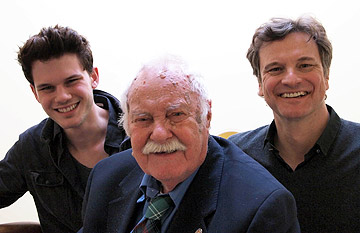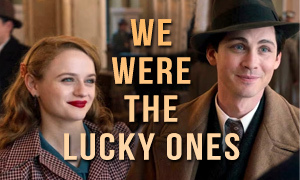The Railway Man: History vs. Hollywood
based on the book 'The Railway Man' by Eric Lomax
| REEL FACE: | REAL FACE: |
Colin Firth
Born: September 10, 1960 Birthplace: Grayshott, Hampshire, England, UK | Eric Lomax
Born: May 30, 1919 Birthplace: Edinburgh, Scotland, UK Death: October 8, 2012, Berwick-upon-Tweed, England, UK (myasthenia gravis) |
Jeremy Irvine
Born: 1990 Birthplace: Gamlingay, Cambridgeshire, England, UK | Eric Lomax (Young)
Born: May 30, 1919 Birthplace: Edinburgh, Scotland, UK Death: October 8, 2012, Berwick-upon-Tweed, England, UK (myasthenia gravis) |
Hiroyuki Sanada
Born: October 12, 1960 Birthplace: Tokyo, Japan | Takashi Nagase
Born: 1918 Birthplace: Kurashiki, Okayama Prefecture, Japan Death: June 21, 2011 |
Tanroh Ishida
Birthplace: Bunkyo, Tokyo, Japan | Takashi Nagase (Young)
Born: 1918 Birthplace: Kurashiki, Okayama Prefecture, Japan Death: June 21, 2011 |
Nicole Kidman
Born: June 20, 1967 Birthplace: Honolulu, Hawaii, USA | Patricia "Patti" Wallace
Born: 1936 Birthplace: England, UK |
Stellan Skarsgård
Born: June 13, 1951 Birthplace: Gothenburg, Västra Götalands län, Sweden | Jim Bradley
Born: June 17, 1911 Birthplace: Stalybridge, Cheshire, England, UK Death: May 19, 2003, Winchester, England, UK (natural causes) |
Sam Reid
| Jim Bradley (Young)
Born: June 17, 1911 Birthplace: Stalybridge, Cheshire, England, UK Death: May 19, 2003, Winchester, England, UK (natural causes) |
How old was Eric Lomax when he joined the military?
Our research into The Railway Man true story revealed that Eric joined the Royal Corps of Signals when he was twenty and departed for Southeast Asia in 1941. The Royal Corps of Signals are a combat support arm of the British army responsible for setting up battlefield communications. In addition to providing the telecommunications infrastructure in the field, the Corps of Signals also engage in electronic warfare, scrambling enemy communications, radar, etc.

Read the Book. The movie (left) is based on Eric Lomax's 1995 memoir (right).What was Eric's job as a Japanese POW?

Read the Book. The movie (left) is based on Eric Lomax's 1995 memoir (right).
Eric and his fellow POWs were forced to build a railway from Thailand to Burma in order to provide a land route to supply the Japanese army that was there. Thousands of soldiers perished in the process, mostly due to malnutrition, overwork and disease. -History Extra
Were the POWs rescued from their duties on the railroad by the arrival of allied forces following the Japanese surrender?
Not exactly. As Dr. Philip Towle of the University of Cambridge points out in the History Extra article "Historian at the Movies: The Railway Man reviewed," the movie compresses the war to make the audience think that the prisoners were still suffering on the railroad at the time of their rescue. In reality, the railway had been completed, to the extent that it was ever going to be, and at that point the main dangers to the POWs were disease, starvation, Allied bombing, and the constant realization that the Japanese would likely kill all of them at the end of the war.
Was Patti Eric's first wife?
No. Completely absent from The Railway Man movie are Eric Lomax's first wife Agnes ("Nan"), whom he married on November 20, 1945, just three weeks after he was liberated. He had been courting her in their native Edinburgh prior to leaving for the war in 1941. Eric and Nan got engaged the night before he left. Following his capture by the Japanese after the fall of Singapore in 1942, Nan waited for three-and-a-half years not knowing whether he was alive or dead. After the war, they were together for 37 years and shared three children: Linda May Lomax (born December 14, 1946, died December 13, 1993), Eric Lomax Jr. (born June 18, 1948, died at birth), and Charmaine Carole Lomax (born June 17, 1957). In his 1995 book, Eric refers to Nan merely as "S." He left her in 1981. -The Guardian
Did Eric and Patti meet on a train?
Yes. While riding on a train to Glasgow in 1980, the real Eric Lomax met the then 43-year-old Canadian nurse Patricia "Patti" Wallace, who was seventeen years his junior and back in Britain visiting her mother, sister and some close friends. A fondness for one another developed and in 1982, Patti left Canada for the United Kingdom, her place of birth. Soon after, Eric officially ended his marriage with Nan and married Patti in 1983. "It was hard," says daughter Charmaine, "but we wanted to concentrate on our mum. Dad had made life very tough for her: Mum deserved better." -The Guardian

Colin Firth and Nicole Kidman portray Eric and Patti Lomax in The Railway Man movie (left). The real Eric and Patti Lomax share a moment of happiness together (right).
Had Patti been married prior to Eric?
Yes. In his book, Eric states that Patti, portrayed by Nicole Kidman in the movie, had been in a marriage that was as reduced as his own. She had grown up in England where she became a nurse, but she moved to Canada after marrying her first husband who was part of the Canadian air force. Eric and Patti were "both living rootless and not altogether happy lives." Patti had three sons of her own, Graeme, Nicholas and Mark, and she also had a daughter. -The Railway Man book
What did Eric do when he came home from the war?
In researching The Railway Man true story, we learned that not only did Eric Lomax have to deal with his physical and emotional scars from the war, he also had to face the reality that while he was a prisoner of war, his mother had died and his father had remarried, leaving Eric without a place to call home. Upon his return, he ended up staying with his fiancée Nan and her parents, a living situation that likely hastened their impending nuptials.
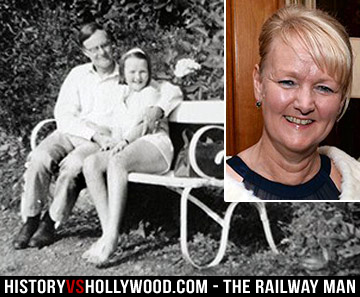
The real Eric Lomax with his daughter Charmaine in the late 1960s. Charmaine (inset at the 2013 movie premiere), her sister, and mother were left out of the film.
Eric went to work for the Colonial Office and he was posted to West Africa to help construct a 600-mile railway traversing what is today Ghana. His first wife Nan and their daughter Linda went with him. While there, his son Eric Jr. was born in Takoradi, but the baby only survived for four hours. The family returned from Africa in 1955, and Eric went on to work as a lecturer at Strathclyde University. An emotional chasm had developed in his marriage. Eric became distant and he struggled with meeting the demands of daily life, including paying the bills. To make matters worse, his daughter Linda had a brain hemorrhage when she was 12. Linda recovered but was faced with lasting complications, which eventually claimed her life in 1992 at the age of 46. -The Guardian
Did Eric's emotional scars from the war cause his first marriage to crumble?
Not entirely. In his book, Eric describes petty feuds and vendettas that were ongoing between his first wife's family, which began immediately following their wedding in 1945. "This intolerance over things so surpassingly trivial was very hard for me to take. I had felt less morbid vindictiveness towards the Japanese guards in Changi than these seemingly normal Scottish middle-class people were displaying to their own blood relatives. Marriage can be like incarceration without a key, as I was beginning to find out." In his book, he often counters such statements by saying that his inability to articulate his searing memories from the war was equally to blame, if not more so.
Did Eric see his children after he separated from his first wife in the early 1980s?
No. Eric's daughters, Linda and Charmaine, cut off contact with him after he left their mother. Charmaine didn't see her father again until her sister Linda died in 1993 at the age of 46. She suddenly found herself standing between her mother and father at Linda's graveside. Following the funeral, Eric asked her if she'd meet him sometimes for a cup of tea. She began to see him every year and a half or so, and more often after her mother died in 2003. However, Charmaine says that their time together was not easy since he still never talked about his feelings, but she's glad that they were at least in touch. -The Guardian
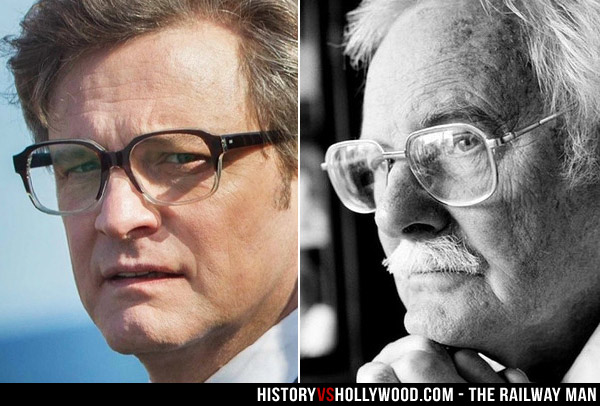
Unlike Colin Firth's character in the film (left), the true story behind The Railway Man movie reveals that the real Eric Lomax (right) had been married for 37 years and had 3 children prior to meeting Patti (Nicole Kidman's character).
Was Eric Lomax's daughter upset that she, her sister, and her mother were left out of the movie?
No. Eric Lomax's daughter Charmaine wasn't upset that she, her sister Linda, and her mother Nan were left out of The Railway Man movie. She doesn't blame the movie's screenwriter, Frank Cottrell Boyce. She says that it goes back to her father, who had left them out of his book. "But we were always there," Charmaine says. "What happened to him happened to us, too." -The Guardian
Did the POWs, including Eric Lomax, really endure the unspeakable horrors seen in The Railway Man movie?
Yes. Though it is at times hard to watch, the Japanese army's treatment of the POWs who worked on the Burma-Siam railway is accurately portrayed in the movie. Years of schooling had indoctrinated young Japanese men with the notion of Emperor worship, and their training to become soldiers in their native country was based on brutality. The soldiers were also taught to fight with relentless ferocity as part of the Japanese counter-insurgency against Mao Tse-tung's forces. All of these factors played a part in creating soldiers who could carry out the most cruel acts of torture without a second thought. -History Extra
As Eric himself states in his book, past movies like David Lean's The Bridge on the River Kwai (1957) gave a misleading impression of POW life. "Who ever saw such well-fed POWs?" Eric writes. Many Americans believed Lean's film to be true and perhaps slept better because they were left with a false picture of POW life, one that ignored the unspeakable horrors that the POWs had endured in the hands of the Japanese. By the time the war ended, Eric himself weighed only 105 pounds, roughly 60 pounds less than his average, pre-war weight. In all, of the more than 60,000 Allied troops captured by the Japanese, approximately 12,399 prisoners died (VancouverSun.com).
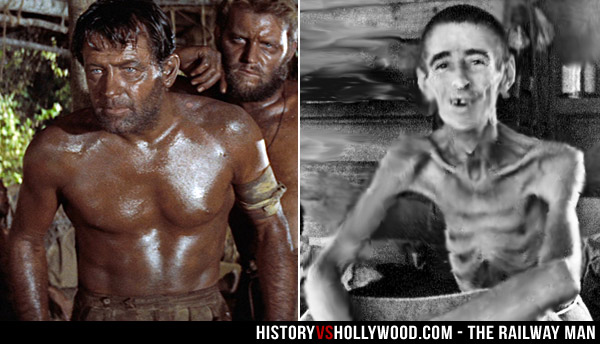
William Holden's well-fed character in 1957's The Bridge on the River Kwai (left) stands in stark contrast to the reality of being a POW of the Japanese. This includes the experience of British POW Jack 'Becky' Sharpe, pictured on the right in Changi Hospital shortly after the war ended (which is why he's grinning).
Were Eric and six comrades really tortured for building a secret radio to follow the progress of the war?
Yes. The radio was discovered by the Japanese in August 1943. As punishment, Eric and his six comrades were first forced to stand out in the searing heat for hours without water or food. Then the Japanese soldiers stomped on them and beat them unconscious with pickaxe handles. Two of the POWs did not survive.
For Eric, the punishment for the radio did not end there. He was left lying on the ground for two days. His ribs were cracked and his arms and hips were broken. The Japanese then subjected him to more interrogation and torture. They kept him in a coffin-sized cage for hours at a time. Eric was found guilty of "anti-Japanese activities" and was sentenced to five years hard labor. He was transported to a disease infested jail, where he spent the rest of the war. -Daily Mail Online
Did Eric's wife Patti really encourage him to seek psychological help for his nightmares?
Yes. Eric Lomax's second wife Patricia "Patti" Wallace, portrayed by Nicole Kidman in the film, encouraged him to seek help for his nightmares, rages and feelings of isolation (The Railway Man book). She told him that she was going to leave him if he did not seek help. "My dad's feelings were locked inside himself," says Charmaine, his daughter from his first marriage. "He was there physically, but emotionally he was 100% absent" (The Guardian).
Did Eric Lomax really write the poem that Colin Firth's character recites in the movie?
Yes. The poem is an Eric Lomax original. He would recite it in his darkest hours in an effort to help isolate his mind and feelings during difficult times. It is displayed below. -Glam Adelaide
Then dropped the dew and the clock struck two
From the dew grew a tree and the clock struck three
The tree made a door and the clock struck four
Man came alive and the clock struck five
Count not, waste not the years on the clock
Behold I stand at the door and knock.
How was Eric Lomax eventually able to talk about his horrific experiences as a POW?
Not shown in the movie, the real Eric Lomax benefited psychologically with the help of the Medical Foundation for the Care of Victims of Torture (known today as Freedom from Torture), a British charity that provides therapeutic care for survivors of torture. It marked the first time that Eric was able to talk about his experiences at length and helped him to prepare for his meeting with one of his former Japanese tormentors. -History Extra
Did Eric really recognize Takashi Nagase's face in a newspaper clipping?
Yes. The Railway Man true story confirms that in 1989 the real Eric Lomax did in fact recognize the Japanese interpreter Takashi Nagase in a Japan Times newspaper clipping that was given to him by a fellow POW. He remembered how Nagase would bark at him in broken English, accusing him of being a spy, while the other Japanese soldiers tortured him. -Daily Mail Online
Is the Finlay character portrayed by Stellan Skarsgård based on a real person?
Not entirely. The "Uncle Finlay" character is a composite of several POWs that Eric Lomax was friends with. There is no one named "Finlay" in The Railway Man book. However, with regard to the book, Finlay seems to most likely resemble Jim Bradley, a fellow POW who had been in the bed next to Eric's in Changi, Singapore in 1944. Eric reconnected with Bradley in 1989, and it was Jim Bradley's wife Lindy who gave Eric the photocopy of the article from the August 15, 1989 edition of the Japan Times, which contained a picture of Takashi Nagase, Eric's former tormentor. Unlike the movie, Bradley did not commit suicide.
In the article that accompanied the photo, it talked of Nagase's ongoing battle with heart disease, stating that each time he suffered a heart attack, he had flashbacks of the Japanese military police in Kanchanaburi torturing a POW accused of having a map of the railway. Eric immediately knew that he was the POW that Takashi Nagase was referring to. -The Railway Man book
Did Eric Lomax really track down his former captor with the intent to kill him?
No, but Eric's wife Patti says that until he set eyes on his former Japanese tormentor, Takashi Nagase, he had been threatening to do him harm. However, The Railway Man true story reveals that, unlike the film, the real Eric Lomax's intention was more about finding closure rather than seeking revenge. The movie depicts Eric (Colin Firth) meeting with his unsuspecting former captor in order to seek retribution, only to change his mind during the encounter. This is largely fiction that was injected into the film in order to build suspense for dramatic effect. -History Extra
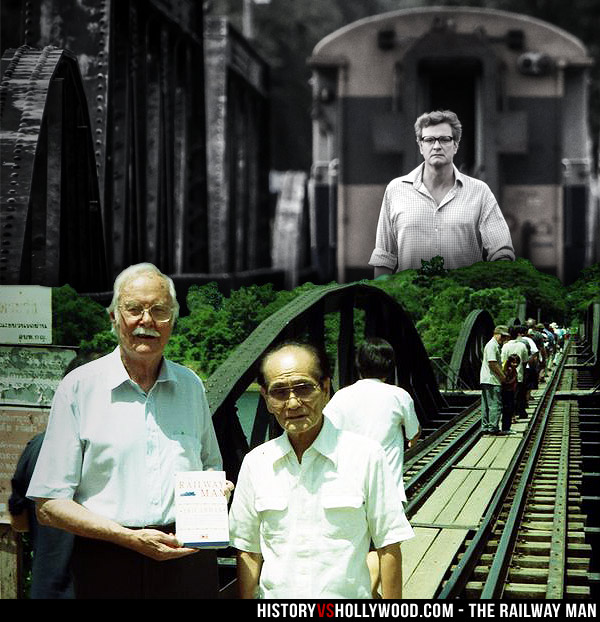
Eric Lomax (Colin Firth) revisits his past by walking across the bridge over the River Kwai in the movie (top). Eric Lomax and his former torturer, Takashi Nagase, pose on the bridge with Eric's book in the 1990s (bottom).
In reality, it was Eric's wife Patti who made the first contact with the then 71-year-old Takashi Nagase. "How can you feel 'forgiven', Mr. Nagase, if this particular former Far Eastern prisoner of war has not yet forgiven you?" Patti wrote. In response to her letter, Nagase wrote back to her, "The dagger of your letter thrusted me into my heart to the bottom." -Daily Mail Online
Did Eric's former tormentor, interpreter Takashi Nagase, really have no idea Eric was coming?
No. Takashi Nagase knew Eric was coming to see him, as Eric's visit was never based on seeking revenge. As indicated earlier, correspondence had prepared Nagase for the meeting. -History Extra
Where did Eric Lomax meet his former Japanese tormentor Takashi Nagase?
The emotionally loaded reunion between Eric Lomax and Takashi Nagase (pictured below) took place in Thailand on March 26, 1993 at the World War II museum in Kanchanaburi near the bridge over the River Kwai. Eric's wife Patti made the trip with him and was there for the first meeting, as was a documentary film crew that was recording the encounter (see the video below). Eric later wrote that the reunion gave him "a resolution for which I had been searching for years." Eric and Patti saw Takashi Nagase and his wife Yoshiko several times after the first meeting and they also kept in touch via phone calls and letters.
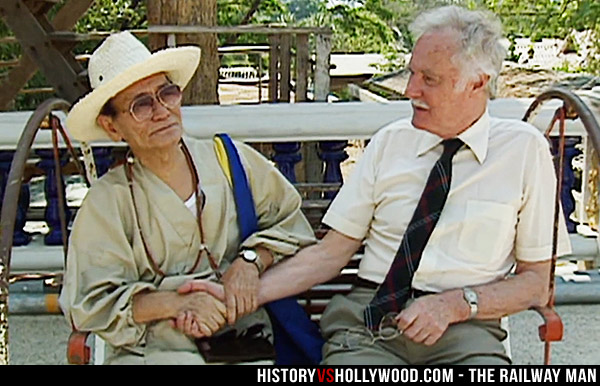
The real Eric Lomax (right) confronts his former tormentor, Takashi Nagase (left), in Thailand on March 26, 1993. Unlike in the movie, Nagase knew Lomax was coming and the meeting was civil.
Was Takashi Nagase remorseful for his treatment of the POWs?
Yes. In the years following the war, Imperial Japanese Army officer and interpreter Takashi Nagase made more than sixty missions of atonement to the River Kwai in Thailand (as of Lomax's 1996 book). Nagase also became a devout Buddhist and as part of his atonement financed a Buddhist peace temple near the bridge on the River Kwai. As Eric Lomax states in his book, Takashi Nagase did not "make reparation some occasional thing; it was truly almost a way of life..."
Did Eric Lomax forgive his former tormentor Takashi Nagase?
Yes. In his memoir, Eric writes, "Meeting Nagase has turned him from a hated enemy, with whom friendship would have been unthinkable, into a blood-brother. If I'd never been able to put a name to the face of one of the men who had harmed me, and never discovered that behind that face there was also a damaged life, the nightmares would always have come from a past without meaning."
How did Eric Lomax remember everything that happened to him by the time that he wrote the book in the mid 1990s?
Immediately following his return from World War II, Eric wrote a 40,000 word manuscript detailing his experiences. Following his reconciliation with Takashi Nagase, he revisited his detailed account and developed it into his autobiography, The Railway Man.
How did Eric Lomax die?
Eric passed away on October 8, 2012 from a muscle-deteriorating condition called myasthenia gravis, which he had been suffering from for the final decade of his life. -Daily Mail Online
Have any other films been made about Eric Lomax?
Yes. Mike Finlason's 1995 documentary Enemy, My Friend? features footage of Eric Lomax's 1993 reunion with his former torturer, Takashi Nagase. Also, shortly after Lomax's book was published in 1995, the Everyman TV series featured an episode starring John Hurt, titled "Prisoners in Time," in which Hurt portrays Eric Lomax, an ex-prisoner of war who comes face to face with his former Japanese torturer.
The Railway Man Interviews & Related Video
After reading about The Railway Man true story vs. the movie above, check out the related videos below, including footage of Eric Lomax meeting Takashi Nagase, Eric visiting The Railway Man movie set, a news segment remembering his life, and the movie trailer.
WATCH Eric Lomax and Takashi Nagase Meeting for the First Time Since WWIIThis powerful clip shows former POW Eric
Lomax meeting Takashi Nagase, his Japanese
tormentor, for the first time since World
War II. "As a member of the Japanese army,
we treated your country very, very badly,"
Nagase tells Lomax. As Takashi Nagase
opens up to Lomax, he takes hold of
Lomax's arm, remembering where it had been
broken when he was tortured. |
WATCH Colin Firth Meets Eric Lomax on SetWWII veteran Eric Lomax pays a visit to
the set of The Railway Man
starring Colin Firth and Nicole Kidman.
Colin Firth chats with Lomax in several
brief clips and Nicole Kidman can be seen
talking with Eric's wife, Patti Lomax, her
counterpart in the film. Sadly, Eric
passed away before the movie was
completed. |
WATCH Eric Lomax RememberedThis BBC segment aired shortly after Eric
Lomax's death in 2012. It features photos
and clips of Lomax recalling his torture,
his experience as a POW held by the
Japanese, and his eventual reunion with
his tormentor, Takashi Nagase. |
WATCH The Railway Man TrailerColin Firth portrays World War II prisoner
of war survivor Eric Lomax, who years
later attempted to reconcile with the past
that haunted him by tracking down one of
his Japanese captors. In the film, Nicole
Kidman portrays his second wife Patti and
Stellan Skarsgård portrays his best
friend Finlay. Watch The Railway
Man movie trailer for an overview of
the movie's interpretation of the story,
which was adapted from Lomax's book of the
same name. |
Link-to-Learn More:
